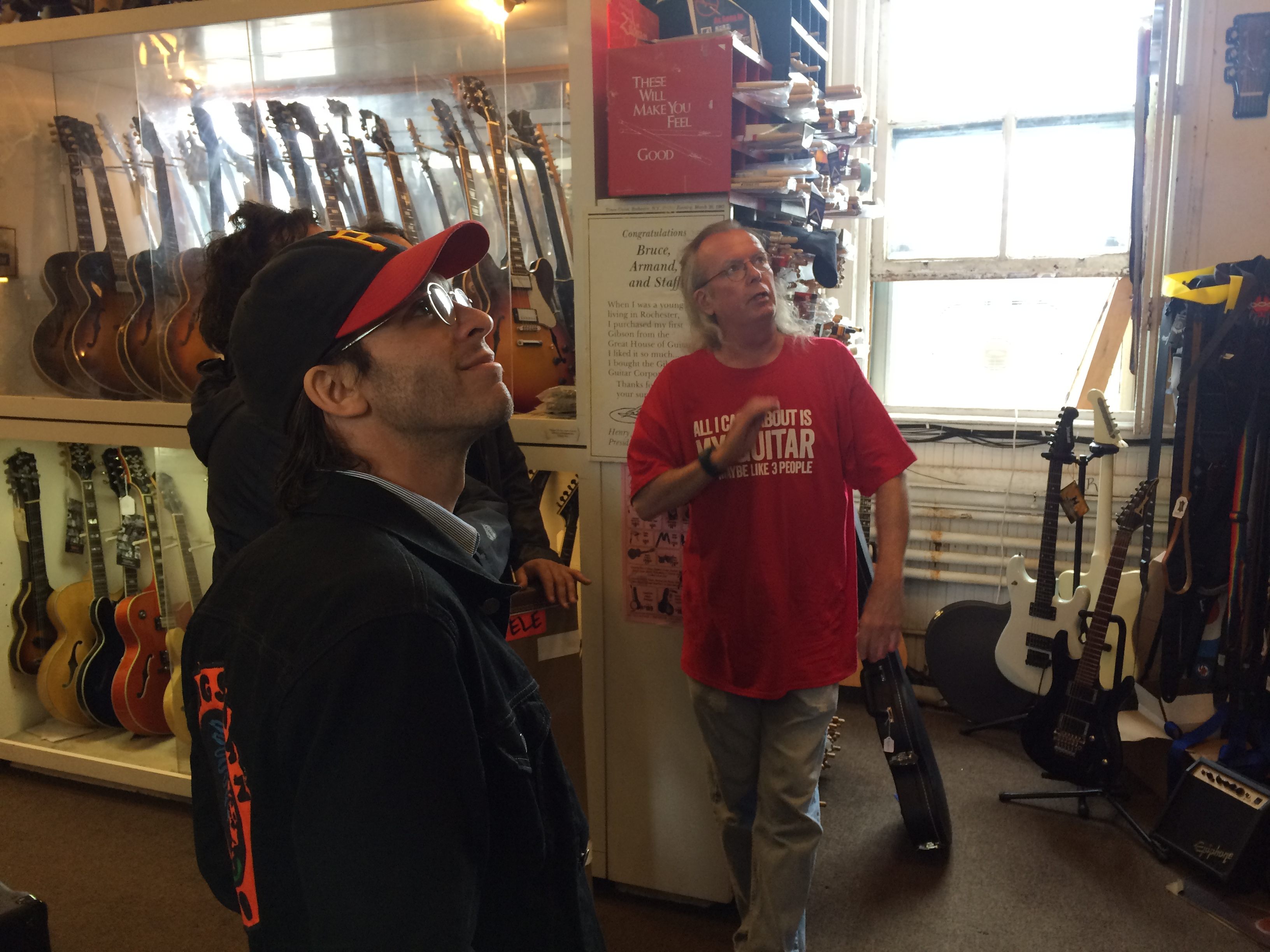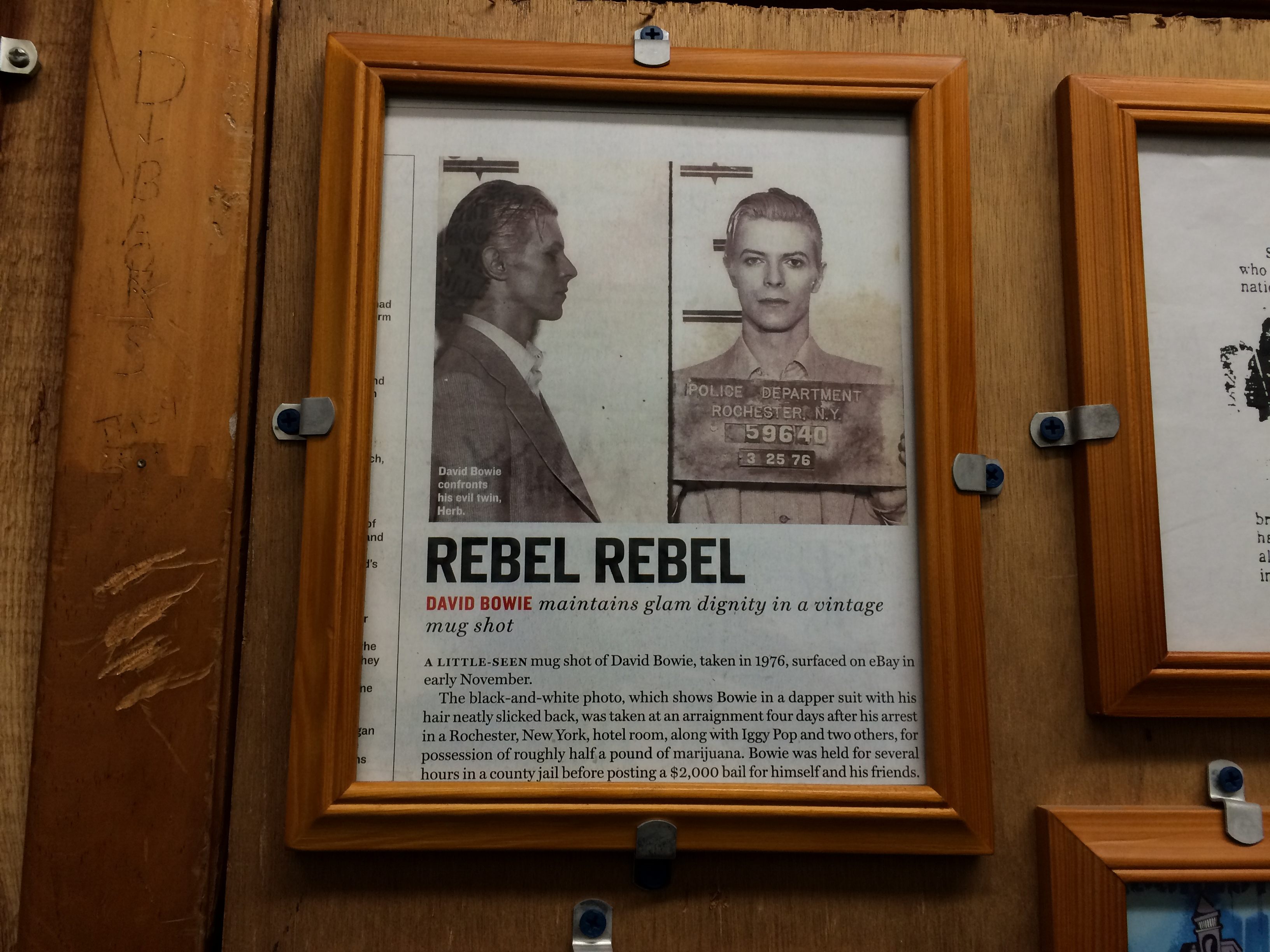On Tour with The War on Drugs: Rochester’s Church of Gear

The church of gear: Rochester’s House of Guitars. All photos by Jon Natchez.
For the next few weeks, The War on Drugs’ Jon Natchez is going to be sharing his adventures on a current tour. Like any touring musician, Natchez experiences a very specific form of travel, the kind where you usually have 24 hours, tops, to explore a new city. This is the first installment in his Atlas Obscura tour diary.
Today got off to a bit of a slow start; over the weekend we played a couple big festivals, which are always manic and draining. So we slept in a bit and puttered around the bus. Standard morning activity: drinking coffee, eating breakfast, discussing Game of Thrones. (Thrones discussion has become a central part of the band experience, but I haven’t seen any of the show. So I just sit there, feeling like I’m hearing a recap of a very dramatic D&D campaign. )
This is first proper show of the tour and we have a couple new crew members plus some new gear. So we wanted to get set up early to give folks a chance to get their bearings. The venue is the somewhat storied Water Street Music Hall, right in downtown Rochester, a classic example of the type of venue our drummer Charlie calls a “rock toilet”. Decades of grime caked on floors and walls, broken everything in the bathrooms, a smell of rust, mildew, cleaning products, and stale beer. It’s a symptom of my touring-musician Stockholm syndrome that I love this smell.
The early load-in left the entire afternoon free for the band to go to House of Guitars. Most musicians love to nerd out about gear, and I can usually nerd out with the best of them, but this band takes gear worship to another level. I’ve never known anyone who knows more about guitars and amplifiers than Adam (the band’s lead singer, guitar player, and songwriter), and everyone else in the band runs a close second.
The House of Guitars is the perfect venue to indulge such passions. And going on local explorations is my favorite tour activity—hence this diary. So a few of us—Adam, Charlie, Anthony, our other guitarist, and I—piled into our runner’s car and drove about 20 minutes from the venue to the shop.

Anthony smiles as he hears about some of House of Guitars’ most prized instruments.
Calling the House of Guitars a “shop” doesn’t really do the place justice; it’s some mix of museum, funhouse and hoarder’s garage. The building is a warren of passages and strange half-staircases, mirrored cabinets filled with gear, boxes of unsorted music-related miscellanea, and endless displays of music memorabilia, running the geeky gamut from a Les Paul guitar signed by Les Paul to a flute signed by Ian Anderson to a violin signed by Charlie Daniels. Some of the guitars—such as a 1953 Les Paul Goldtop, a 1966 12-string non-reverse Firebird, a 1954 Esquire—are literally priceless.The store (also literally) overflows with unique instruments, both hard-to-find vintage pieces and new custom guitars built by Fender and Gibson for the shop. And while the upper floors are divided into a maze of rooms, the bottom floor is a giant open warehouse-type space crammed with a dizzying array of vinyl, CDs (many still in longboxes), piles of sheet music, rows upon rows of used band and tour t-shirts, and other various genres of music-related detritus. It’s an overwhelming amount of EVERYTHING, and you want to paw through it all in search of the undiscovered gem that is surely somewhere right in front of you. And then you want to submerge your entire body in a tub of Purell.


Top: Charlie digs for 45 rpm gold. Above: The overflowing basement.
The employees are all lovable gearheads who were excited to chat with a group of interested musicians. Their vibe (and for that matter, our vibe) was neatly expressed on a t-shirt one of them was wearing: “All I Care About Is My Guitar And Maybe Like 3 People”. On one hand, the world of gear obsession of is eminently mockable: obsessives with Vitamin D deficiencies endlessly arguing over their toys. But, on the other hand, that obsession is a direct outgrowth of a passion for music; once you fall in love with making music, you’re always searching for and excited by the possibility of new tones and new sounds. Every new guitar or new keyboard or new pedal promises a new world to explore. Plus, there is an intrinsic magic to a vintage, high-end instrument. Holding a beautiful old guitar, or bass, or horn, or whatever, you can just feel the heft and elegance of great craftsmanship. And there’s even more magic in the wear of an old instrument: the slickness of a guitar neck that has been played for three decades, the way your fingers will just slot into little grooves on the fretboard that have been subtly worn in over the years.
 Memorialization of one of the great moments in Rochester rock history: David Bowie’s outrageously dapper mugshot.
Memorialization of one of the great moments in Rochester rock history: David Bowie’s outrageously dapper mugshot.

A small sample of the instruments on display.
One of many haphazard piles of amps.
Even if instruments/equipment aren’t your thing, House of Guitars is still one of those institutions that has accumulated a fascinating history. A 50-foot long wall, once painted white, is completely covered with thousands of signatures of visiting bands and musicians visiting over the decades. A fun game: searching for the names of musicians you love (hey there’s Steve Diggle from the Buzzcocks!) scattered among the hundreds of dustbin-of-history bands (hey there’s Buxx!) that never made it. I’m a little bit obsessed with band lore, particularly the almost/should have/never made it stories of obscure groups, and it’s kind of wonderful and tragic and overwhelming to look at the sheer volume of all the Buxxes on the wall. Each one traversed an complete arc, writing songs, practicing, getting out on tour, recording and releasing albums, dreaming of a big breakout, ultimately not breaking through and then breaking up, experiencing some measure of glory and tragedy along the way. A novel, or at least a short story, behind every one of those fading signatures.

Photos of the shop’s owner posing with various visiting luminaries over the years.
There’s also a pretty fantastic photo wall-of-fame, dozens of shots of various visiting music luminaries posing with the shop owner, Armand Schaubroeck. Schaubroeck himself is an essential part of the House of Guitars experience: He founded the store out of the basement of his mother’s house in 1964, and still is at the shop daily. He regaled us with tales of his late ’60s band, Armand Schaubroeck Steals. I haven’t checked out their music, but on display in the store are two of their album covers and they are spectacular. According to Schaubroeck, they moved to New York City, where Andy Warhol became enamored of them, but it all fell apart after Valerie Solanas shot Warhol, and they moved back to Rochester.
Again: every band has some weird and fascinating (and probably not exactly factual) story. Also worth noting: the wonderful low-budget commercials Schaubroeck has made over the years for the shop, which are legendary among Rochester locals.
 Wall of signatures featuring various notables and not-so-notables.
Wall of signatures featuring various notables and not-so-notables.

Steve Diggle!
Anyway, Adam ended up trading in a Telecaster he doesn’t play any more for a really sweet old Gibson Discoverer amp, and then we went back to the club for soundcheck. At this point in the day—4pm or so—the working day for the band really starts: soundcheck, a break for dinner, getting ready for the show, playing the show, breaking down and loading out. All that activity takes us to about midnight. At that point, I headed to the somewhat musty Rochester Plaza Hotel, where we had our day room. I wanted to grab a shower before retiring to the bus. The hotel was dark and quietand on the door to room 540 was this crumpled sign: “No one is allowed in this room. Do not open it for any employee or contractor no matter what. The only person allowed in this room is Paul Kremp.” That detail seemed like a very Rochesterian thing to see before bed.








Follow us on Twitter to get the latest on the world's hidden wonders.
Like us on Facebook to get the latest on the world's hidden wonders.
Follow us on Twitter Like us on Facebook